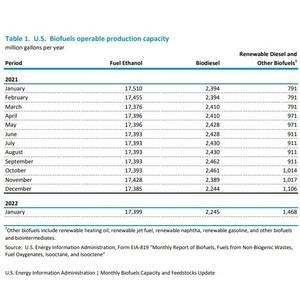EIA: US biofuel capacity up in January, feedstock use down

April 1, 2022
BY Erin Krueger
U.S. operable production capacity for fuel ethanol, biodiesel, and renewable diesel all increased in January, according to data released by the U.S. Energy Information Administration on March 31. Feedstock use was down when compared to the previous month.
Operatable ethanol production capacity reached 17.399 billion liters in January, up 14 million gallons when compared to the 17.385 billion gallons of capacity reported for December. When compared to January 2021, ethanol production capacity was down 111 million gallons.
Biodiesel production capacity increased slightly in January, to 2.245 billion gallons, up 1 million gallons when compared to the 2.244 billion gallons of capacity reported for December. When compared to January 2021, biodiesel capacity was down 149 million gallons.
Capacity for renewable diesel and other biofuels, defined to include renewable heating oil, renewable jet fuel, renewable naphtha, renewable gasoline and other biofuels and biointermediates, expanded to 1.468 billion gallons in January, up 362 million gallons when compared to the 1.106 billion gallons of capacity reported for December. When compared to January 2021, capacity for renewable diesel and associated biofuels was up 677 million gallons.
Advertisement
Advertisement
Overall operatable biofuels production capacity in the U.S. was at 21.112 billion gallons in January, up 377 million gallons from the 20.735 billion gallons reported for December and up 417 million gallons when compared to the 20.695 billion gallons of capacity reported for January of last year.
Total feedstock consumption was at approximately 27.827 billion pounds in January, down from an estimated 28.938 billion pounds in December and 24.774 billion pounds in January 2021.
According to the EIA, 25.957 billion pounds of corn went to biofuel production in January, down from 26.761 billion pounds the previous month, but up from 23.354 billion pounds in January of last year. Biofuel producers also consumed 139 million pounds of sorghum in January, down from 153 million pounds in December. The EIA withheld data on grain sorghum consumption in January 2021 to avoid disclosure of individual company data.
Advertisement
Advertisement
Approximately 791 million pounds of soybean oil went to biofuel production in January, down from 937 million pounds in December, but up from 683 million pounds in January 2021. Corn oil consumption was at 249 million pounds in January, down from 301 million pounds the previous month, but up from 213 million pounds in January of last year. Canola oil consumption was at 64 million pounds, down from 126 million pounds in December. The EIA withheld data on canola oil consumption in January 2021 to avoid disclosure of individual company data. Data on the consumption of other vegetable oils for January 2022 and December 2021 was also withheld for the same reason.
According to the EIA, biofuel producers also consumed 364 million pounds of yellow grease, 141 million pounds of beef tallow, 43 million pounds of white grease, and 15 million pounds of poultry fat in January. Consumption for those feedstocks was at 368 million pounds, 160 million pounds, 51 million ponds and 20 million pounds, respectively in December, and at 263 million pounds, 84 million pounds, 53 million pounds and 34 million pounds, respectively, in January 2021. The EIA withheld data on the consumption of other waste oils, fats and greases for January 2022 and December 2021 in order to avoid disclosure of individual company data but reported consumption of those feedstocks was at 6 million pounds in January 2021.
An additional 64 million pounds of feedstock classified as other recycled feeds and wastes was consumed in January, up from 61 million pounds in December, but flat with the 64 million pounds of consumption reported for January 2021.
Additional data is available on the EIA website.
Related Stories
The USDA significantly increased its estimate for 2025-’26 soybean oil use in biofuel production in its latest World Agricultural Supply and Demand Estimates report, released July 11. The outlook for soybean production was revised down.
The U.S. Energy Information Administration maintained its forecast for 2025 and 2026 biodiesel, renewable diesel and sustainable aviation fuel (SAF) production in its latest Short-Term Energy Outlook, released July 8.
XCF Global Inc. on July 10 shared its strategic plan to invest close to $1 billion in developing a network of SAF production facilities, expanding its U.S. footprint, and advancing its international growth strategy.
U.S. fuel ethanol capacity fell slightly in April, while biodiesel and renewable diesel capacity held steady, according to data released by the U.S. EIA on June 30. Feedstock consumption was down when compared to the previous month.
XCF Global Inc. on July 8 provided a production update on its flagship New Rise Reno facility, underscoring that the plant has successfully produced SAF, renewable diesel, and renewable naphtha during its initial ramp-up.
Upcoming Events










